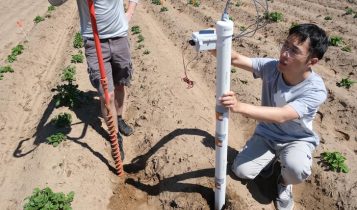High-tech Stickers Could Help Farmers and the Environment
A lot of people got into houseplants during the pandemic. I was among them. One of the things I learned was the importance of fertilizing. My daughter, a biologist, would bring me nutrient-rich water when she cleaned her aquarium so I could use it on my plants (nitrates are a byproduct of fish poop). They loved that dirty fish water, but it was easy to overdo it. I could have used the new stickers out of Wisconsin that help farmers monitor and manage their soil.
Engineers at the University of Wisconsin–Madison have developed low-cost sensors for real-time, continuous monitoring of nitrate levels in Wisconsin soils. These printed electrochemical sensors aim to help farmers make precise nutrient management decisions, potentially leading to significant cost savings.
“Our sensors could give farmers a greater understanding of the nutrient profile of their soil and how much nitrate is available for the plants, helping them to make more precise decisions on how much fertilizer they really need,” says Joseph Andrews, an assistant professor of mechanical engineering at UW–Madison who led the research.
Nitrate is crucial for crop growth, but excess amounts can leach into groundwater, posing health risks and environmental damage. The new sensors can also serve as research tools to monitor nitrate leaching and develop best practices to mitigate its harmful effects. Traditional soil nitrate monitoring methods are expensive and labor-intensive, lacking real-time data. Andrews and his team created potentiometric sensors using an inkjet printing process adapted for soil use by adding a hydrophilic polyvinylidene fluoride layer that blocks soil particles and facilitates accurate nitrate measurement.

CREDIT: Photo by Kuan-Yu Chen
The team tested the sensors in sandy and silt loam soils, common in Wisconsin, and achieved accurate results. They are now incorporating these sensors into a multifunctional system called a “sensing sticker,” which includes moisture and temperature sensors. Attached to rods and buried in soil, these stickers will take measurements at multiple depths, allowing researchers to quantify nitrate leaching and movement through the soil.
Further testing is planned for summer 2024 at UW–Madison’s Hancock and Arlington Agricultural Research Stations. The researchers are patenting their technology through the Wisconsin Alumni Research Foundation.

